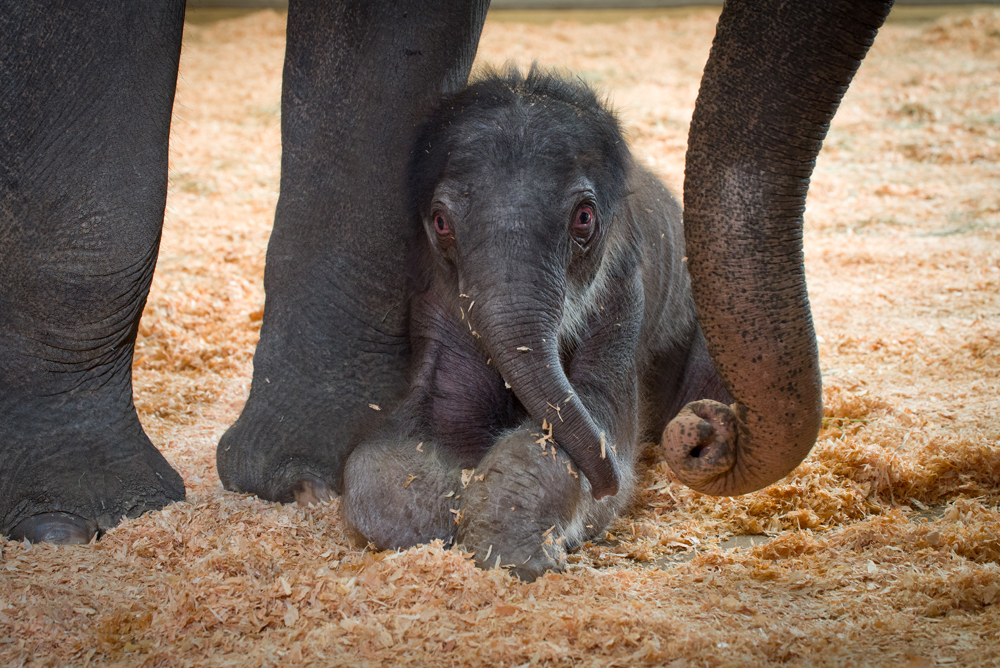The logic used to justify elephant captivity and breeding in zoos is no longer appropriate. It’s time to rethink what living in captivity actually means, starting with Portland’s Oregon Zoo.
The zoo’s 5-year-old elephant, Lily, died on Nov. 29—the day before her 6th birthday—from elephant endotheliotropic herpesvirus, a commonly fatal virus found in older elephant calves. Lily first began showing symptoms 12 hours before her passing and was diagnosed only one day earlier. The Oregon Zoo closed its doors to visitors the next day, allowing the staff and other elephants to grieve.
While captivity may or may not have been the cause of her death, the tragedy has brought a renewed sense of awareness to the inherent cruelty elephants face in captivity and the questionable ethics of elephant breeding.
Lily is the result of a seemingly sketchy breeding program which demonstrates zoos’ desperation for more elephants. Upon birth, she didn’t legally belong to the Oregon Zoo; she was the property of the controversial private traveling show company Have Trunk Will Travel, an organization notoriously under fire for legitimate animal rights and abuse concerns. The Oregon Zoo officially bought Lily for $400,000 from the show company that uses chains and bullhooks to force elephants to perform circus-like tricks after huge public outcry.
Being connected to Have Trunk Will Travel not only reinforces elephant involvement in circuses—a demoralizing life on the road and a cycle of animal exploitation—but breeding contracts, in general, distract from the real problem with elephants in captivity.
Elephants are dying out in zoos, with an infant mortality rate at 40 percent—triple that of either Asian or African elephants in protected areas in the wild. In the last 18 years, more than half of the 76 elephants that have died in captivity never reached the age of 40. The average lifespan for elephants is 70 years in the wild.
Increased breeding in captivity was unsuccessfully used as a corrective measure to make up for elephant deaths. However, according to PBS, breeding inevitably leads to more infant deaths and causes psychological damage to mothers, who can mourn their offspring for years to come. We need to ask ourselves: Are we breeding elephants for the good of the species or for human benefit?
Furthermore, zoos are not sufficient in providing acceptable quality of life to elephants. Space is a major issue; elephants walk up to 50 miles a day, and lack of mobility and movement can lead to physical problems. At the Oregon Zoo, the elephant enclosure is six acres in total. Elephants also suffer from neurotic behaviors, such as head bobbing and pacing and psychological damage such as boredom and depression in captivity. Other zoos have shut down their elephant enclosures and moved their elephants to sanctuaries better equipped to provide adequate space, namely the San Francisco Zoo in 2004.
Why is the Oregon Zoo knowingly breeding elephants in inadequate conditions for health and mental well-being? One of the reasons is elephants are big business, constantly spiking zoo attendance. At their essence, zoos are meant to entertain the public, just like a llama—that was actually an alpaca—in pajamas at Portland State.
Zoos continue to disregard scientific data and analysis that prove elephants are not thriving in captivity, and people are taking notice. A vigil was held outside the Oregon Zoo three days after Lily’s death to protest failed breeding programs, and over 100,000 individuals have signed a petition by Free the Oregon Zoo Elephants calling the zoo to discontinue breeding practices, the buying, selling and trading elephants and the use of bullhooks.
Zoos may not be evil, but they are not sanctuaries. Taking actions to breed more elephants in captivity is unethical and selfish as conditions stand now. The Oregon Zoo should instead be focusing on taking animals out of potentially harmful circumstances.
Correction: This article was updated on December 17th 2018 to delete inaccurate information stating that the Woodland Park Zoo in Seattle sent their elephants to a sanctuary. The elephants were in fact sent to the Oklahoma Zoo.
I am at PSU pursuing an art history major and am minoring in Gender, Sexuality and Queer Studies and Design Management. I took on the role of opinion editor in summer 2018. When I started writing for the opinion section last year as a contributor, I was looking to learn about journalism and media; I can say I definitely have. As an editor, I focus on creating environments in which writers and readers can connect and engage in productive conversations exploring new points of view.






Hello Katherine,
Very sad story. I am quite aware of these issues. Thank you for writing. I live in the State College area and am glad to to know of your awareness of these issues.
Deb
Thank you Katharine! You make excellent points. Please join with Free the Oregon Zoo Elephants in urging a boycott of the zoo until this failed breeding program stops. For Lily, for Rama, Packy, Stoney who died after being sold to a circus in his twenties, for Tina, who died in her 30s from foot disease, for all the dead babies and young elephants born at the zoo and now dead, please remove your financial support from the Oregon Zoo until this cruel breeding ends.
just one correction: Woodland Park Zoo in Seattle did not send their elephants to sanctuary, but instead to the Oklahoma Zoo, despite the best efforts of Friends of Woodland Park Zoo Elephants.http://www.freewpzelephants.com/